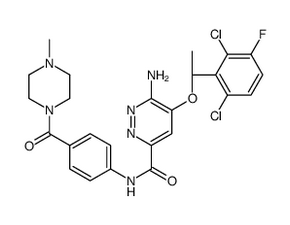
Ensartinib
CAS No. 1365267-27-1
Ensartinib( X396 | X-396 | X 396 | Ensartinib )
Catalog No. M17258 CAS No. 1365267-27-1
Ensartinib (X-396) is an orally available small molecule inhibitor of the receptor tyrosine kinase anaplastic lymphoma kinase (ALK) with potential antineoplastic activity.
Purity : >98% (HPLC)
 COA
COA
 Datasheet
Datasheet
 HNMR
HNMR
 HPLC
HPLC
 MSDS
MSDS
 Handing Instructions
Handing Instructions
| Size | Price / USD | Stock | Quantity |
| 2MG | 39 | In Stock |


|
| 5MG | 80 | In Stock |


|
| 10MG | 110 | In Stock |


|
| 25MG | 244 | In Stock |


|
| 50MG | 405 | In Stock |


|
| 100MG | 551 | In Stock |


|
| 200MG | Get Quote | In Stock |


|
| 500MG | Get Quote | In Stock |


|
| 1G | Get Quote | In Stock |


|
Biological Information
-
Product NameEnsartinib
-
NoteResearch use only, not for human use.
-
Brief DescriptionEnsartinib (X-396) is an orally available small molecule inhibitor of the receptor tyrosine kinase anaplastic lymphoma kinase (ALK) with potential antineoplastic activity.
-
DescriptionEnsartinib, also known as X-396, is an orally available small molecule inhibitor of the receptor tyrosine kinase anaplastic lymphoma kinase (ALK) with potential antineoplastic activity. Upon oral administration, X-396 binds to and inhibits ALK kinase, ALK fusion proteins and ALK point mutation variants. Inhibition of ALK leads to the disruption of ALK-mediated signaling and eventually inhibits tumor cell growth in ALK-expressing tumor cells. ALK belongs to the insulin receptor superfamily and plays an important role in nervous system development.(In Vitro):The ability of X-376 to inhibit the growth of different cancer cell lines harboring ALK fusions or point mutations is tested. X-376 is potent in H3122 lung cancer cells harboring EML4-ALK E13;A20 (IC50: 77 nM). X-376 is also potent in H2228 lung cancer cells harboring EML4-ALK E6a/b; A20 (IC50: 57 nM). Furthermore, X-376 is potent in SUDHL-1 lymphoma cells harboring NPM-ALK (IC50: 32 nM). X-376 also inhibits SY5Y neuroblastoma cells harboring ALK F1174L, MKN-45 gastric carcinoma cells harboring MET dependent, HepG2 cells and PC-9 lung cancer cell lines harboring EGFR exon 19 del with IC50s of 142 nM, 150 nM, 15.137 μM and 3.062 μM, respectively. (In Vivo):The effects of X-376 in vivo against H3122 xenografts are examined. A pharmacokinetic study reveals that X-376 shows substantial bioavailability and moderate half-lives in vivo. Nude mice harboring H3122 xenografts are treated with X-376 at 50 mg/kg bid. X-376 significantly delays the growth of tumors compared to vehicle alone. In the xenograft experiments, X-376 appears well-tolerated in vivo. Mouse weight is unaffected by X-376 treatment. Drug-treated mice appear healthy and do not display any signs of compound related toxicity. To further assess potential side effects of X-376, additional systemic toxicity and toxico-kinetic studies are performed in Sprague Dawley (SD) rats. Following 10 days of repeated oral administration of X-376 at 25, 50, 100 mg/kg in SD rats, all animals survive to study termination. The no significant toxicity (NST) levels are determined to be 50 mg/kg for X-376. At NST levels, X-376 achieves an AUC of 41 μM×hr and a Cmax of 5.04 μM.
-
In VitroThe ability of X-376 to inhibit the growth of different cancer cell lines harboring ALK fusions or point mutations is tested. X-376 is potent in H3122 lung cancer cells harboring EML4-ALK E13;A20 (IC50: 77 nM). X-376 is also potent in H2228 lung cancer cells harboring EML4-ALK E6a/b; A20 (IC50: 57 nM). Furthermore, X-376 is potent in SUDHL-1 lymphoma cells harboring NPM-ALK (IC50: 32 nM). X-376 also inhibits SY5Y neuroblastoma cellsharboring ALK F1174L, MKN-45 gastric carcinoma cells harboring MET dependent, HepG2 cells and PC-9 lung cancer cell lines harboring EGFR exon 19 del with IC50s of 142 nM, 150 nM, 15.137 μM and 3.062 μM, respectively.
-
In VivoThe effects of X-376 in vivo against H3122 xenografts are examined. A pharmacokinetic study reveals that X-376 shows substantial bioavailability and moderate half-lives in vivo. Nude mice harboring H3122 xenografts are treated with X-376 at 50 mg/kg bid. X-376 significantly delays the growth of tumors compared to vehicle alone. In the xenograft experiments, X-376 appears well-tolerated in vivo. Mouse weight is unaffected by X-376 treatment. Drug-treated mice appear healthy and do not display any signs of compound related toxicity. To further assess potential side effects of X-376, additional systemic toxicity and toxico-kinetic studies are performed in Sprague Dawley (SD) rats. Following 10 days of repeated oral administration of X-376 at 25, 50, 100 mg/kg in SD rats, all animals survive to study termination. The no significant toxicity (NST) levels are determined to be 50 mg/kg for X-376. At NST levels, X-376 achieves an AUC of 41 μM×hr and a Cmax of 5.04 μM.
-
SynonymsX396 | X-396 | X 396 | Ensartinib
-
PathwayCytoskeleton/Cell Adhesion Molecules
-
TargetGlucokinase
-
RecptorALK
-
Research AreaCancer
-
Indication——
Chemical Information
-
CAS Number1365267-27-1
-
Formula Weight547.41
-
Molecular FormulaC25H25Cl2FN5O3
-
Purity>98% (HPLC)
-
SolubilityDMSO : ≥ 37 mg/mL 67.59 mM
-
SMILESc1(cc(c(nn1)N)O[C@H](C)c1c(c(ccc1Cl)F)Cl)C(=O)Nc1ccc(cc1)C(=O)N1CCN(CC1)C
-
Chemical Name(R)-6-amino-5-(1-(2,6-dichloro-3-fluorophenyl)ethoxy)-N-(4-(4-methylpiperazine-1-carbonyl)phenyl)pyridazine-3-carboxamide.
Shipping & Storage Information
-
Storage(-20℃)
-
ShippingWith Ice Pack
-
Stability≥ 2 years
Reference
1. Caccese M, et al. Expert Opin Pharmacother. 2016 Dec;17(17):2253-2266.
molnova catalog



related products
-
Tryptophan N-indol-3...
Indole-3-acetyl-L-tryptophan is involved in regulatory mechanisms for the control of auxin activity during physiological and pathophysiological responses. It may also be used in the synthesis of β-D-galactosidase and β-D-glucosidase inhibitors.
-
POMHEX
Pomhex, a cell-permeable potent enolase inhibitor with anticancer activity, is used in the study of cancer lethality.Pomhex, a racemic mixture, is a potent and selective ENO2 inhibitor.
-
Castanospermine
Castanospermine is a natural compound that inhibits α- and β-glucosidases, especially glucosidase l.



 Cart
Cart
 sales@molnova.com
sales@molnova.com


